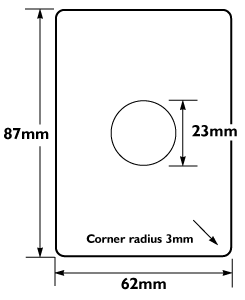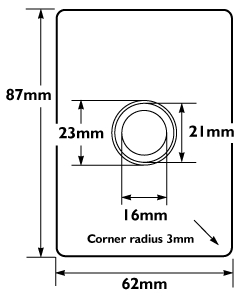

SpecificationSheet: Business Card CD-ROM (77Mb)
 |
 |
| Please
make document size: 62mm x 87mm |
If
printing spot colours please spec them as such DO NOT use RGB colours |
| For
CD spec 1: DO NOT print within the 23mm hole |
Any scans/pictures/images used please supply as Tiffs or EPS files ONLY!! |
| For
CD spec 2: DO NOT print anything within the 23mm and 21mm rings within the 16mm hole |
Please
supply artwork in Quarkxpress format for MAC or PC supplying ALL fonts used If this is not possible supply in: Illustrator EPS/Freehand EPS/Corel Draw EPS |
| Do NOT put any bleed | making sure you convert all type to curves/outlines |
| No type to be smaller than 6pt | Supply
artwork on: 3.5" Floppy / CD-R / ZIP |
| No tint to be less than 15% and >90% | E-Mailed artwork is NOT accepted |
Business
Card CD-ROM Film Specifications
On-Body
Artwork
A silk screen process
is used for printing Business Card CD-ROM and on-body artwork can be digitally
supplied as and must adhere to the following guidelines.
Printing can either be up to 5 pantone (spot) colours or the 4 colour process,
plus a white base colour if required.
Please note: there is a commercial rate applied for all film work carried out
on behalf and a minimum turnaround of 24 hours.
For each colour (up
to a maximum of five) a separate film must be supplied as follows:
a) Positive, right side reading, emulsion up.
b) Minimum type size of 6pts.
c) Registration marks should be placed at least 5mm outside the area of the
card.
d) All guide lines should be removed from supplied finished films.
e) Specify if you require a white base. If no white base is used in four-colour
printing, there will be a metallic look to the finished print due to the silver
of the CD showing through the links.
Half
Tone or Spot Colour Printing
a) Screen ruling -
85/100 lines per inch.
b) Screen angle - 45o for Singletone + 75o for Duotone + 15o for Tripletone.
c) Dot shape - Elliptical.
d) Dot density range is 15% - 90%, anything outside this range will not print.
e) Solid areas, where possible, need to be placed on separate films, since the
viscosity of the ink for Half Tone and Solid areas is different. This is particularly
relevant where solid black or very dark colours are required.
4
Colour Process Printing
a) Screen ruling -
100, 110 or 133 lines per inch.
b) Dot shape - Elliptical
c) Dot density range is 15% - 90%, anything outside this range will not print.
e) Screen angles are very important. Please use the following angles:
|
Colour
|
Angle
|
Alternative
|
Alternative
|
| Cyan C |
75°
|
172.5°
|
165°
|
| Magenta M |
45°
|
52.5°
|
45° |
| Yellow Y |
0°
|
7°
|
0°
|
| Black K |
15°
|
112.5°
|
105
|
Artwork
Guidelines
a) There must be no
text or graphics outside the template area or inside the centre hole, i.e. no
bleed.
b) Colours - either Pantone spot colours or full colour process CMYK (not RGB).
c) Tint - Any tint must be between 15% and 90%.
d) Type - No type should be smaller than 6pts (including text in logos).
e) All picture files should be either TIFF or EPS format - do not use JPEG.
Origination
Formats
a) QuarkXpress (PC
or Mac)
b) Illustrator (PC or Mac)
c) PageMaker (PC or Mac)
d) Freehand (Mac)
Proofs
a) Low grain Cromalin
is preferred (ideally in matt finish for more accurate colour registration)
b) Digital Cromalin is acceptable (though colour matching is less accurate)
c) Laser and inkjet-printed proofs are not acceptable for colour matching, but
may be used as rough guides.
d) Please note there may be dot loss in screen printing on CDs, which can result
in lighter colours than on paper (where dot gain occurs). A low grain cromalin
will therefore give the best colour match.
Files should be supplied as CD-R, Zip Drive or ISDN complete with a colour proof.
July 2001
©Copysoft Limited 2001